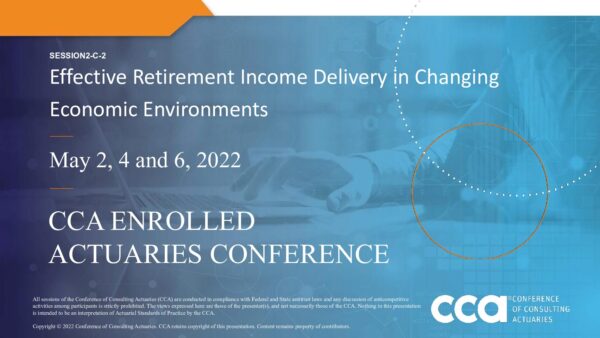Research on the Decumulation Problem

Effective Retirement Income Delivery in Changing Economic Environments
By Peter Neuwirth, FCA, FSA / Barry Sacks Ph.D. JD, Law offices of Barry H. Sacks / Jim Berberian, FCA, ASA, EA, MAAA / James Buck, Buck Global, LLC
Antitrust Policy: Professional societies, including the Conference of Consulting Actuaries (CCA), are subject to federal and state antitrust laws, and must constantly monitor their activities to ensure continued compliance with all antitrust regulations.

Peter Neuwirth, FSA, FCA
Purpose of Antitrust Laws: The antitrust laws prohibit any concerted activity or combination of competitors from interfering with free competition. In other words, the primary thrust of the law is to control private economic power by protecting competition. Persons and organizations are prohibited from engaging in any action which unreasonably restrains commerce or trade (i.e., competition). Per se, violations (practices presumed to be inherently wrong regardless of the motivating factors) include agreements to fix or stabilize prices, divide markets, allocate production, or impose boycotts. In essence, this means any concerted action that significantly diminishes rivalry among competing firms.
Disclaimer: Opinions expressed are not necessarily those of the presenters, their employers, or the sponsoring organization.
Agenda
- Rethinking what retirees need to thrive in retirement in the current environment
- Replacing the 3- legged stool with 3 tools for the retiree’s backpack
- The Decumulation problem
- Final Thoughts/Q&A
Scroll down for more!

Barry H. Sacks
Retirement Income Planning: The old model
Beginning in the 1950s and continuing through the early part of this century, the metaphor of the “3-legged stool” was used to help individuals think about their financial security and how it could be provided during their retirement.
The 3-legged stool consisted of
- Social Security (provided by the Government)
- A guaranteed Pension (provided by the employer)
- Personal Savings (provided by the individual)
Retirement Income: We need a new model
- Beginning in the 1990’s and accelerating through today two of the three legs of the stool became unstable, and the third can’t now make up the difference
- Social Security’s future solvency is now uncertain as actuarial projections show that if nothing is done, by 2033 all benefits including those in payment status will be automatically reduced by 25%
- Very few companies provide a guaranteed pension anymore as most employer sponsor retirement programs are now DC and more and more employment is “gig” work and not covered by any retirement plan
- The third leg (personal savings) is now overburdened and so a new model is needed
- A new Model – 3 tools for the current world
- One possible model is to recognize that individuals must rely on their own resources to achieve financial wellness.
- Therefore, we propose a new model, which considers 3 financial tools for individuals to carry in their metaphorical backpack as they follow the trail of life. Each of these tools can be acquired by an individual on their own, though each requires an investment of time, money or both.
We will consider the following 3 tools/assets to draw from in retirement
- Home Equity
- Employer provided Retirement Programs (e.g. 401(k))
- Insured products (e.g. Life Insurance and annuities)
Social Security will almost certainly survive in some form but could easily be radically redesigned and therefore should not be counted on by individuals unless they are approaching retirement age.
Applying the new model
- The order in which individuals acquire each asset should be congruent with their goals, desires, family circumstances, earnings capacity etc., but there are the many other factors that should determine which tool they acquire and when.
- With the exception of annuities (longevity insurance), the earlier in a person’s career they acquire the asset/product, the greater is the range and value they will get from it over a working career and through retirement
- Depending on how early a person acquires one of these assets a person can expect to use each of these tools in different ways at different points in their life.
Home Equity
For more than 100 years, young people starting out have sought to buy a home. Today it is more challenging than ever, but to our minds, the benefits of home ownership are more varied and more important than ever and manifest themselves throughout one’s entire adult life. For example, a home can be:
- A place for you and your family to live
- Temporary shelter for friends and family
- A source of ready cash obtainable through a HELOC
- A means of building debt capacity and improving your credit rating
- A means to build wealth that can accumulate or be invested elsewhere through cash out refinancing
- A source of income through renting out extra rooms
- A place to work from by using a home office
- An important source of retirement income and contingency funds by obtaining a HECM after turning 62
- A legacy to leave your heirs
Employer Provided Retirement Programs
- By far the most common retirement programs that employers offer to their full and part time W-2 employees is some sort of Defined Contribution account-based plan, usually a 401(k) or 403(b) savings Plan
- Most people will not work for one company for their entire career, so it is important to consider what role accumulating a tax-sheltered investment portfolio will play over an entire working career. This is particularly important in the first half of an individual’s career
- Approaching retirement age, it becomes even more important to stay cognizant of the Retirement Programs sponsored by the employer. After age 55 many Qualified Plans allow more flexibility for investment and distribution elections
Life Insurance and Annuities
- Permanent Life Insurance has been much maligned as inferior to “buy term and invest the difference”, but while that may be more “efficient,” it misses important aspects of Permanent Life Insurance products with a Cash Value feature that are designed to be flexible, versatile and useful over one’s entire life.
- Such products can act like a Swiss Army Knife – not the best at anything, but good enough to use for multiple purposes.
- An annuity is essentially a Longevity Insurance policy and different kinds of annuities (QLAC’s, Fixed, Variable, etc.) can serve different purposes in retirement, but all can be purchased by individuals on their own
The Decumulation Problem
- Retirement planning in today’s environment requires individuals to solve the decumulation problem
- The decumulation problem is distinctly different from the challenge of accumulating assets during one’s working years and has unique challenges that are not present before retirement
- There is no closed form solution, and our view is that it is best done piecemeal utilizing different strategies to overcome each of its unique risks
Financial Risks of Decumulation
There are 5 distinct financial risks that a retiree faces as they try to sustain themselves for the remainder of their lives, only the first two of which are present during the accumulation phase. These risks include
- investment/inflation risk (present during accumulation)
- specific investment liquidity risk (present during accumulation)
- sequence of returns risk (unique to decumulation)
- unpredictable contingent expense risk (unique to decumulation)
- longevity risk (unique to decumulation)
Approaches to Decumulation
Historical approaches to decumulation (e.g. the 4% rule) have focused on drawing down from a single “bucket” (i.e., the securities portfolio – typically, but not necessarily, a 401(k) account or a rollover IRA). These approaches have proven generally unsuccessful and inadequate to address the unique aspects of the decumulation problem.
During the accumulation phase defined contribution plan accounts are funded; but also, several other “buckets” are often acquired and funded and are appropriate for then-current purposes. (For example, a home provides shelter, and life insurance provides financial protection for young families.) During the decumulation phase, these buckets can become part of a more useful “multi-bucket” approach to the provision of retirement income than the single-bucket approach.
Decumulation – Sequence of Returns Risk
- Sequence of returns risk (SOR) is present for retirees whose primary source of income is a securities portfolio (e.g., a 401(k) account)
- SOR arises from the confluence of 2 factors: 1) The volatility of the securities portfolio from which the retiree is distributing income; and 2) The need to sell some of the securities to meet living expenses when the portfolio is at a low point in its volatility cycle
- SOR can be mitigated through a 2 bucket “coordinated strategy” of drawing from Home Equity (via a HECM) when portfolio returns are negative and from the portfolio when returns are positive
- The following compares this “coordinated strategy” to a “last resort strategy” where the portfolio is drawn from until it is exhausted and home equity must be used (either via sale or HECM)
Mitigating Sequence of Returns Risk
Probability of Cash Flow Survival: Retiree with initial portfolio value $400,000 and initial home value $800,000. Blue line: Coordinated Strategy; Red Line: Last Resort Strategy.
Decumulation – Longevity Risk
- Longevity risk only becomes apparent as individuals age and stay healthy
- An early purchase of a QLAC’s (pure longevity insurance) is one possibility, but our modeling indicates that while QLACs can be effective, other types of annuity purchase are less efficient
- Maintaining a buffer asset appears to be an alternative and possibly more efficient method of mitigating that risk
- The challenge is to preserve the buffer asset while maintaining a desired standard of living
- Using Home Equity as that buffer asset via the coordinated strategy can accomplish that to some degree
Decumulation – Longevity Risk
Use of coordinated strategy preserves significant (mostly invested) assets after 30 years of retirement to address longevity risk
Decumulation – Unpredictable Contingent Expense Risk
- While the “coordinated strategy” is effective at addressing sequence of returns risk and helps address longevity risk it does not address the real risk that a sudden/temporary increase in a retiree’s living expenses (e.g. as a result of a health or personal crisis or a major repair needed on a home) can arise at a time that requires liquidity that is not easily accommodated by the HECM or the investment portfolio
- In such cases, a third “bucket” of assets may be required to allow retirees to sustain themselves over the long term
Decumulation – the “3 bucket approach”
- We are currently researching whether the “Coordinated Strategy” described above can be extended by adding a specific “third bucket” (a cash value life insurance policy) to mitigate both the unpredictable contingent expense risk and to further assist in addressing the longevity risk inherent in decumulation
- So far, results look promising, but research is ongoing
Decumulation – Final Thoughts
- The decumulation problem is one of the most important retirement planning challenges facing the individuals and those organizations involved in assisting people with their financial plans
- The actuarial profession is uniquely qualified to address this challenge and the scope of potential research in this area is significant
- While the “3 bucket approach” discussed above may get us closer, there is still much work to be done
